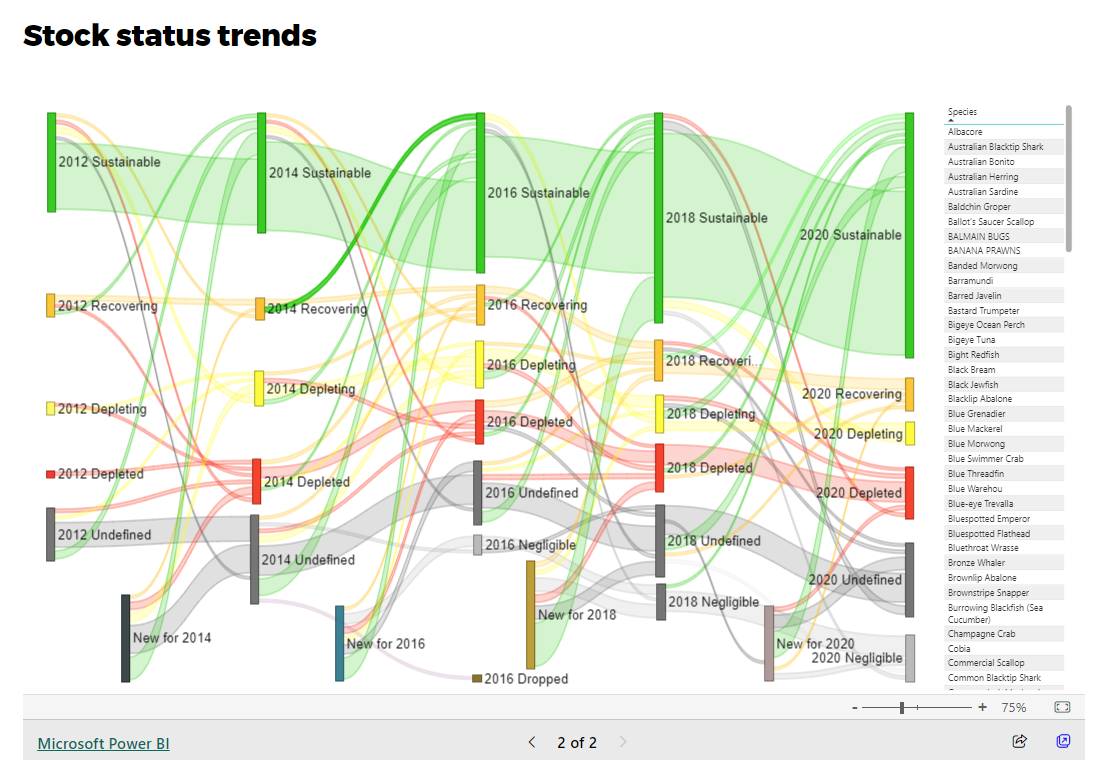The most comprehensive assessment of the biological sustainability of Australian fish stocks has been completed with the release of the Sixth edition of the Status of Australian Fish Stocks (SAFS) reports.
SAFS shows 316 of the 503 fish stocks are sustainable.
This report serves as a vital assessment tool, employing a nationally agreed framework to evaluate the abundance of fish and current harvest levels. This information is used to help support the long-term viability of these populations and the ecosystems they inhabit.
85% of Australian fish stock species assessed, were classified as either ’sustainable’ or ’recovering’
Each SAFS report details stock statuses at a jurisdictional stock level using an intuitive traffic light system, which, for example, helps consumers determine if their favourite seafood is sustainable, recovering, depleting, or depleted.

SAFS paints a comprehensive picture for researchers and fishery managers, providing information on basic biology, catch graphs and the fisheries targeting each species, including fishing methods, management techniques, and catch data.
Into new waters
This year's edition marks an expansion, incorporating an additional seven species (including the sought-after Redspot Emperor (Lethrinus lentjan) and desirable Striped Marlin (Kajikia audax)) as well as 25 new stocks. Toby Piddocke, FRDC Research Portfolio Manager who led the SAFS project, says this growth reflects Australia’s commitment to comprehensive monitoring and responsible fisheries management.
“SAFS is now covering more than 90% of the stocks Australians consume, so fewer species will be added in the future unless substantial new data suddenly becomes available,” Toby says.
“It’s safe to say that the majority of species Australians eat are already under thorough scrutiny.”
However, Toby highlighted that the report also serves as a roadmap, signifying areas where further research or management adjustments may be necessary.
“A minority of stocks in SAFS will come up as undefined,” Toby explains. “SAFS can be seen as driving research priorities by pinpointing where our knowledge gaps about Australian fish species stocks are.”
Over a hundred Australian fisheries scientists contributed to this landmark report. Each assessment underwent rigorous peer-review by independent experts, ensuring the scientific integrity and reliability of the findings.
Prior to SAFS, stock assessment scientists and fishery managers were often fragmented across jurisdictions. And as Toby pointed out, fish tend not to stick to their jurisdictional boundaries.
“This collaboration piece is almost as important as the data,” Toby pointed out. “All parties involved are now unified under one goal: sustainable fish stocks”.
Picture through time
With over a decade of data collection, there is now substantial data available to the public about stock status trends over time.
“It’s a picture through time,” Toby explains, “showcasing how stock statuses change over time, whether it be through ‘boom or bust’ cycles or a variety of other factors.”
SAFS also delivers in-depth data, such as key results by jurisdiction or state, classifications by fishing gear, and author relationships to species analysis; showcasing the depth of expertise in fisheries scientists, with fisheries scientists often working across multiple species.
“These useful data tools give you a deeper level of analysis than if you read just one report from one year. These SAFS tools offer a deeper dive into the data.”
Helping our (united) nation
Aligned with the United Nations Sustainable Development Goals, SAFS provides the basis for the Australian Governments report against Indicator 14.4 - Proportion of fish stocks within biologically sustainable levels.
By providing a robust, science-based foundation, SAFS empowers researchers, policymakers, and the fishing and aquaculture sectors, to work collaboratively towards a future where Australia's fisheries remain not only productive but prosper in an ecologically responsible way.
“The 2024 SAFS report paints a reassuring picture,” Toby emphasised, “that the vast majority of Australia's assessed fish stocks are considered sustainable, a testament to the effectiveness of current Australian fisheries management regimes.”






